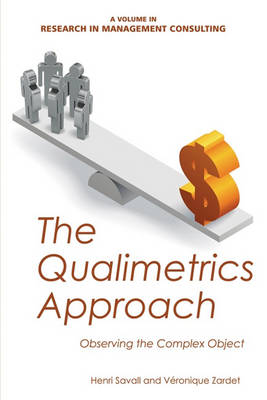Research in Management Consulting
3 total works
This volume is part of an ongoing partnership between the Research in Management Consulting book series and the Socio?Economic Institute for Firms and Organizations (ISEOR), located in Ecully, France, on the outskirts of Lyon. The socio?economic approach to management (SEAM) provides a pathway to creating more engaged, more responsible and responsive, and more productive organizations. In many respects this volume reflects a culmination of ISEOR’s work, drawing together Henri Savall and Veronique Zardet’s insights and framing them in the context of strategy creation and, just as if not more important, strategy implementation.
This volume casts SEAM in the context of strategy development and implementation. Reflecting on the changing nature of work and the workplace, the potential power of—and need to develop and build on—human potential has never been greater. Savall and Zardet have always thought that the Western concept of human resources was misguided, that people are not a resource to use up but rather a source of potential to invest in, develop, and nurture. People bring their potential to the organizations in which they work—and it is their choice as to whether they will apply it in their jobs. Thus, a core managerial challenge is to create an environment in which that potential can be maximized.
SEAM?based strategy builds on this premise, developing an approach to economic and social performance, providing direction as to how managers can create and implement strategies that enhance organizational effectiveness and efficiency. As Savall and Zardet argue, strategic vision does not have to be limited by constraints in the external environment—companies “are not compelled to enter in a `strategic’ tunnel” that mimics the competition and the market. Instead, companies can experience breakthroughs, turning constraints into opportunities by unleashing their internal energy, power, and cohesion, working and succeeding as a team. The SEAM approach to strategy is grounded in innovation and creation far more than imitation—and, as convincingly illustrated in the volume, that creativity can be self?financed through the value?added created by the elimination of organizational dysfunctions and the hidden costs they generate. The volume provides an insightful guide for enhancing economic and social performance, with a useful mixture of specific tools and techniques—grounded in a conceptual view of organizational life—interspersed throughout that illustrate how it can be done.
This volume casts SEAM in the context of strategy development and implementation. Reflecting on the changing nature of work and the workplace, the potential power of—and need to develop and build on—human potential has never been greater. Savall and Zardet have always thought that the Western concept of human resources was misguided, that people are not a resource to use up but rather a source of potential to invest in, develop, and nurture. People bring their potential to the organizations in which they work—and it is their choice as to whether they will apply it in their jobs. Thus, a core managerial challenge is to create an environment in which that potential can be maximized.
SEAM?based strategy builds on this premise, developing an approach to economic and social performance, providing direction as to how managers can create and implement strategies that enhance organizational effectiveness and efficiency. As Savall and Zardet argue, strategic vision does not have to be limited by constraints in the external environment—companies “are not compelled to enter in a `strategic’ tunnel” that mimics the competition and the market. Instead, companies can experience breakthroughs, turning constraints into opportunities by unleashing their internal energy, power, and cohesion, working and succeeding as a team. The SEAM approach to strategy is grounded in innovation and creation far more than imitation—and, as convincingly illustrated in the volume, that creativity can be self?financed through the value?added created by the elimination of organizational dysfunctions and the hidden costs they generate. The volume provides an insightful guide for enhancing economic and social performance, with a useful mixture of specific tools and techniques—grounded in a conceptual view of organizational life—interspersed throughout that illustrate how it can be done.
Edited by Henri Savall and Veronique Zardet, Institut de Socio-Economie des Entreprises et des Organisations A volume in Research in Management Consulting Series Editor Anthony F. Buono, Bentley University The impetus for this work emerged from Savall's belief that there is a doubleloop interaction between social and economic factors in organizations, between behaviors and structures, and between the quality of life in organizations and their economic performance. When managers underestimate this dynamic interaction, the resulting tension ultimately manifests in lowered performance and increased costs, what he refers to as the "hidden costs" of organizational life. Only by delving into the depths of these organizational dynamics can we hope to fully understand - and create the basis for improving - organizational performance. The Qualimetrics Approach presents a different and challenging way of thinking about analyzing organizations, one that draws together quantitative information, financial analysis and qualitative insights into organizational dynamics.
As Savall and Zardet argue, to gain a true understanding of what is happening in organizations, intervener-researchers must focus on all three perspectives, as ignoring any one of them will lead to incomplete understandings. Their approach underscores the importance of using qualitative data to validate quantitative depictions ("the numbers") of organizational performance in understanding the construction of financial statements. The strength of Savall and Zardet's approach is that it pushes us to go deeper, to fully understand the narratives underlying the numbers and the social construction of our financial assessments.
As Savall and Zardet argue, to gain a true understanding of what is happening in organizations, intervener-researchers must focus on all three perspectives, as ignoring any one of them will lead to incomplete understandings. Their approach underscores the importance of using qualitative data to validate quantitative depictions ("the numbers") of organizational performance in understanding the construction of financial statements. The strength of Savall and Zardet's approach is that it pushes us to go deeper, to fully understand the narratives underlying the numbers and the social construction of our financial assessments.
The Dynamics and Challenges of Tetranormalization
by Henri Savall and Veronique Zardet
Published 11 March 2013


